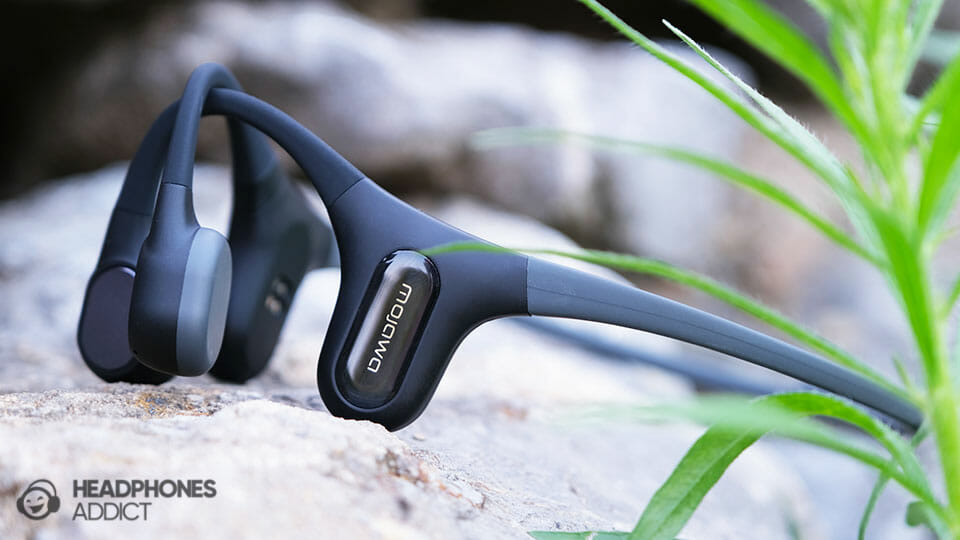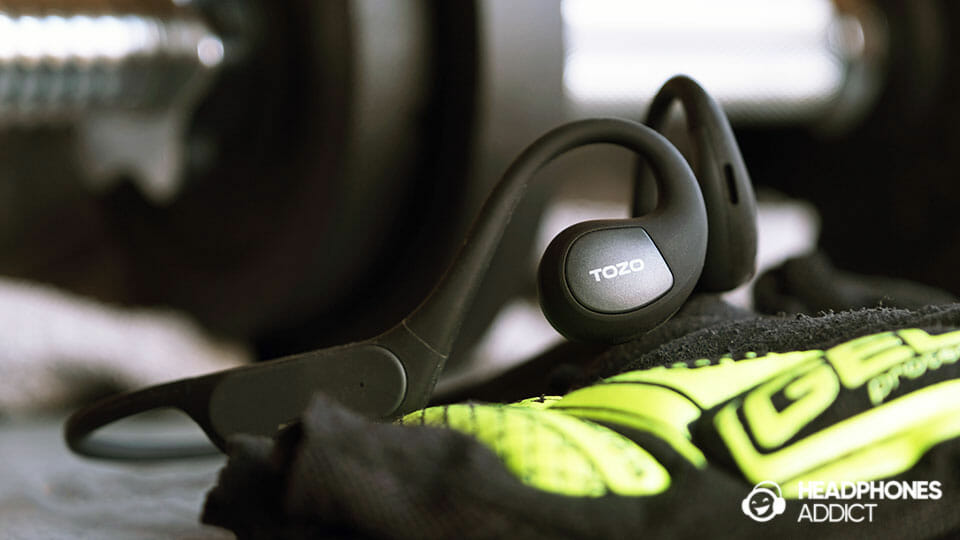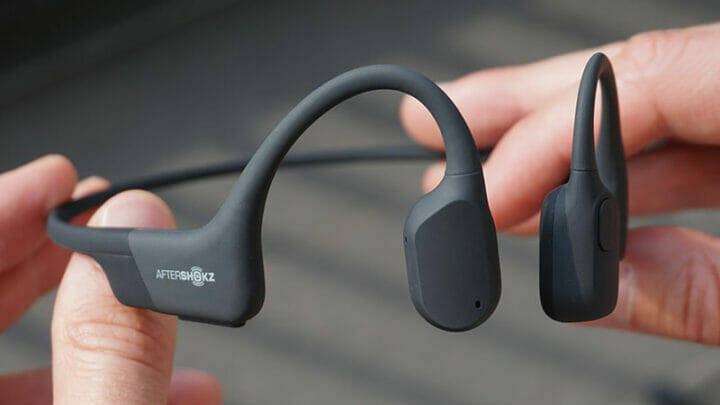
Mojawa Run Plus are ideal bone-conduction headphones for sportspeople and swimmers, thanks to the onboard storage. They even sound great if you exclude the major bass problem.
Run Plus are the new flagship bone-conducting headphones from Mojawa that are an update over the Mojo2 on almost every front (except build quality, which is identical).
Headphones now support a companion app, providing firmware updates, EQ presets, and a few other features.
Most importantly, they also have onboard memory and a set of swimming earplugs, which is perfect for swimmers. For that reason, the Run Plus arrive with an IP68 rating rather than IP67.
Sound quality is also much more balanced compared to other bone-conducting headphones. However, the bass suffers from severe distortion. More on that later.
Are Mojawa Run Plus, despite their flaws, a worthy pick for $150, or should you pick Mojo2? Let’s find out.
Price:
Pros & Cons:
- Most balanced sound from bone-conductive headphones
- Stable fit, suitable for intense sports activities
- Onboard MP3 player for outdoor runners & swimmers
- Quality build with an IP68 rating
- Bluetooth multipoint support
- Mediocre call quality muffles your voice
- Pretty noticeable bass distortion
Category ratings:
See related:
Sound

Mojawa Run Plus are one of the most balanced-sounding bone conduction headphones. They can still get shouty and overly shimmery, but they’re much better than their competitors. However, the bass tends to distort.
The bone conduction technology in the transducer gives a slightly clunky sound. So it doesn’t produce amazing audio quality. However, the Run Plus are a step in the right direction, at least for tuning.
Apparently, 5 Grammy-winning producers sat down and made the tuning (which is somewhat of a reoccurring trend among headphone brands). And they did a good job.
There are some spots where the sound gets a bit harsh, but nothing close to what you usually hear from bone-conduction headphones. That said, transducers struggle with bass, causing distortion.

Bass: Pretty good until it distorts
The bass quantity is pretty low. You can hear some punch and rumble when listening in a quiet room. Otherwise, you’ll mostly feel the gentle vibrations from transducers.
When you hear the bass, it’s decently tight (for bone conduction) and produces faith rumble. That said, don’t expect to hear “deep and resonant bass”, as stated on the official website.
By opening the app, you can switch to a Bass preset that slightly boosts it, but you’ll primarily feel a little more vibrations rather than bass.
If you want a stronger rumble, you must seal your ear canals with the provided plugs, albeit that makes it a bit bloaty. However, all that is expected.

What you don’t expect, though, is a pretty significant distortion in the bass. You don’t hear it immediately, but on songs like “Wild Thoughts” by Rihanna & DJ Khalid, it’s very obvious.
Distortion is present even during a phone call, and you listen to the other person speaking. It’s a strange oversight from Mojawa to let it slide.
Midrange: Quite balanced, albeit a bit thin
Mid-frequencies are the area where Mojawa Run Plus made the most improvements. Compared to other bone-conduction headphones, the mids in these are much closer to a natural sound.
Vocals aren’t just a thin-sounding mess but actually have some body and texture. We can say the same about instruments, especially guitars.
On the other hand, due to the lack of proper bass, the midrange still sounds a bit thin and shouty, especially the vocals. Fortunately, you shouldn’t expect any sibilance.
You can make the mids sound better by using the Vocal preset in the app, however, at the expense of treble energy.
Treble: Good quantity with decent texture and air
Treble performance is also surprisingly good for the type of headphones. Listening to “In The Gallery” by Dire Straits provides a pleasant shimmer from the cymbals and a good overall texture.
Speaking of cymbals, they sound well when the song is relatively calm, like the one from the Straits.
However, they’ll get buried under other things during busy rock tracks. In the song “Lying from You” by Linking Park, loud guitars and vocals mask them completely.

Furthermore, the decay is relatively short, so while cymbals have a lovely shimmer, they quickly sizzle away.
What is most important, the treble quantity is just right, which is excellent.
Their design also helps with a slightly wider soundstage, pushing the sounds further out of your head.
On the other hand, the imaging could be better. You get some directional awareness, but you surely won’t use these headphones for playing competitive mobile games.
Overall, Mojawa Run Plus is an excellent addition to the bone conduction market, with great sound quality. If they could somehow fix the bass distortion over the firmware update, that would be fantastic.
Nonetheless, you’ll hardly hear any of these flaws during sports activities, especially underwater.
Are you interested in finding a great pair for sports? Check these guides out:
Comfort & Fit

Mojawa Run Plus offer a superbly stable fit during intense workouts and remain comfortable during long sessions. However, you first have to get used to them; otherwise, you might get headaches.
Bone conduction headphones are made specifically for sports, so their stability is undeniable.
You can do whatever you want, and they’ll stay on your head.
Run Plus can easily survive jumping and head shaking. They’re even secure enough to stay in place when swimming, although making complex underwater pirouettes might dislodge them.
Construction-wise, headphones are made of silicone, plastic, and titanium, which gives them rigidity. They’re overall light but not the lightest we’ve tried.

The contact points where transducers touch your skin are bare plastic, unlike Mojo2, which were covered in silicone and had small kitty footprints.
Consequently, the contact doesn’t feel as comfy in comparison. You also start sweating a bit sooner. However, the worst thing is that you start feeling them more and more, which can fuel some headaches during the first couple of listens.
Remember that even when you start wearing glasses, you might experience the same thing, and it takes some time to get used to it.
Durability

Mojawa Run Plus are made to withstand the harshest environments, from full water submersion to getting buried in powdery sand. A hard case would also provide drop resistance, but a softer pouch also suffices.
Mojawa tested the Run Plus for an IP68 rating, which means that the Run Plus can now endure underwater for more extended periods (up to 2 hours, according to the official website), which makes them ideal for swimming down to 2 meters (or 6.6 feet).
During our review of the Mojawa Run Plus, we exposed them to sweat, splashes of water, and some dunking into a cup filled with water. Headphones survive all close encounters with water.

Headphones can also resist dust, preventing tiny particles from entering the housing and causing havoc. That’s good to know if you plan to run or cycle on country roads when it’s windy.
As for design, Mojawa Run Plus have a primarily plastic body where you’ll find transducers and modules for volume controls and charging. They’re covered in silicone to feel nicer when in contact with skin.
On the flip side, the back of the headset, the frame, is made of titanium. That offers rigidity and flexibility while keeping the weight down.
All in all, you shouldn’t worry about the durability of the Run Plus. Mojawa even ditched the swirl pattern on the physical control button, which collects dust like crazy, making them easier to clean.
Overall durability gets even better by using the included carrying pouch. It doesn’t offer drop protection, but it should prevent headphones from getting scratched.
Are you a swimmer? Check out:
Battery

Battery test results: Mojawa Run Plus have a battery life of 8 hours and 43 minutes when playing music at 50% volume. While that makes them average, they at least charge very fast, filling up in just 50 minutes.
Mojawa Run Plus Battery Comparison

Bone-conduction headphones have to work more to produce sound compared to regular headphone drivers. Naturally, they consume more energy. So far, only Orange O Bones managed to break the 10-hour mark.
Battery test
In our battery life test, where we leave headphones playing music at 50% volume, the Run Plus managed to last:
- 8 hours and 43 minutes.
Official numbers state that they can play for around 8 hours at 75% volume, which seems somewhat unlikely. Nonetheless, even with our results, you can easily use them for at least two days before searching for a charge.
What is slightly unfortunate is the use of a proprietary charging cable, which means having an extra cable laying around. It also terminates into USB-A, so you need an older power brick or charge the headphones with a computer.

Fortunately, you can expect pretty fast charging:
- Mojawa Run Plus can charge from 0% to 100% in just 50 minutes.
Furthermore, the magnets on the charging pins are soo strong that they easily withstand the weight of the headphones. Unlike TOZO OpenReal, which uses laughably weak magnets on their pins.
Features

Mojawa Run Plus are one of the most feature-packed bone conduction headphones, offering their own app, EQ presets, and built-in storage for offline listening. However, their call quality could be better.
Run Plus are made particularly for extreme sportspeople like trail runners and swimmers. Let’s start with storage.
Built-in music player
Mojawa Run Plus bone conduction headphones offer 32GB of storage for offline listening. That eliminates the need to carry a smartphone that would only slow you down.

You connect the Mojawa headphones using the provided magnetic USB-A cable. They support MP3, AAC, WAV, M4A, APE, and FLAC files, no matter the quality.
One minor issue with this is that only a few people have audio files on their computers, so this solution mostly comes in handy to users who have already used headphones with storage and have a lot of music files.
Unfortunately, you can’t transfer offline playlists from your music streaming service to the headphones, as the app doesn’t support that.
Controls
Headphones use a touchpad and multifunction button to navigate music playback and answer phone calls. Let’s start with a physical button on the left conduction pad.
- Play/pause & answer/end call – one click
- Next track & pause a current call to answer a new call – double click
- Previous track – triple click
- Power on/off – click and hold for 2 seconds
- Switch between MP3/Bluetooth mode – double click and hold for 2 seconds
Touch controls are located on the left module behind your left ear:
- Volume up – swipe up
- Volume down – swipe down (the amount of volume reduced depends on how fast you swipe)
- Normal/shuffle/repeat loop in MP3 mode – double tap
- Activate smartphone’s voice assistant in Bluetooth mode – double tap
One thing to mention is that the touch control sits very close to your earlobe, almost behind it. So, it is pretty tricky to perform swipes.

Companion app
The Mojawa app is new by this point, as the Google Play store only lists around 100 downloads.
However, when scanning the QR code in the manual, it sends you to the Mojawa website, where you download an .apk installation file, and not to Google Play or App Store.
That said, the app offers to update firmware and accurately monitor battery percentage (headphones only tell you whether the battery is low or high when you turn them on).

Inside the settings, you can switch between 4 EQ presets:
- Balanced EQ: offers optimal performance but can occasionally get shouty.
- Swim EQ: boosts midrange and treble so you can hear them better underwater.
- Bass EQ: adds slightly more bass, with a noticeable increase in transducer vibrations.
- Voice EQ: reduces treble and upper midrange to make the sound more forgiving and better tailored when listening in quiet environments.
Furthermore, you can deactivate voice assistant summoning and select the app language, which is currently only limited to English and Mandarin. However, some pop-up messages are still in Mandarin.

Microphone quality
Mojawa Run Plus have a fuller-sounding call quality than the Mojo2, but they appear much more muffled. Even when speaking in a quiet environment.
Mojawa Run Plus microphone test (quiet & background noise):
You get to hear some low-end, which gives your voice some fullness and warmth. However, the high-end is cut off, resulting in a lack of clarity.
Furthermore, the microphone over boosts the input signal, so your voice can sometimes clip and distort. Sure, others can still understand what you’re saying, but they might struggle with some words.
Moving to a noisier place doesn’t help. On top of the muffled voice, you also get background distortion. If you’re making calls near a busy road, others might have difficulty understanding you.
In conclusion, Mojawa Run Plus Bluetooth headphones are all right for making or answering urgent calls. However, pick something else if you plan to make many video or professional calls.
Noise Isolation

Mojawa Run Plus let you hear your surroundings for increased safety, but others can also hear your music due to severe sound leakage. At least they don’t produce much extra wind noise.
Since bone conduction headphones classify as open ears, they have non-existent passive noise isolation. That’s why we test them for wind noise and sound leakage instead.
Starting with wind noise, their performance is pretty good. We don’t hear much extra wind noise produced by headphones when going for a run.
Even cycling doesn’t make things worse, thanks to smaller transducers that prevent creating stronger air drag.

On the other hand, Run Plus bleed sound much more than the Mojo2, which are really quiet in comparison. As a result, people around you can easily hear what you’re listening to.
While that isn’t that big of an issue during outdoor workouts, you can’t enjoy listening to these headphones when someone is in the same room as you (unless you don’t care about bothering them).
Bluetooth

Mojawa Run Plus have a stable close range and a pretty great indoor Bluetooth range of around 50 feet. They support basic Bluetooth codecs but no Game mode, so they lag significantly during mobile gaming.
It’s great to see neckband open-ear headphones like Mojawa Run Plus provide great Bluetooth connection results. They use Bluetooth 5.2 to ensure a stable connection without any hiccups.
Even indoor range results are above average. Walking around the house, we managed to distance ourselves from the transmitting device by:
- 50 feet (15.24 meters)
That’s more than the Mojo2 at 40 feet but slightly worse than Orange O Bones at around 60 feet.

Headphones also support Bluetooth multipoint:
- First, connect them to two different devices individually.
- Then connect them to the first device, enable Bluetooth on the second, and connect them there as well.
- You should hear the voice from the headphones saying, “Second device connected.”
Playback automatically switches to a device that started playing audio the last.
How to pair Mojawa Run Plus?
- When pairing them for the first time, the process starts automatically when you turn them on.
- To pair them to another device, turn them on while holding the button until you hear “pairing.”
What Bluetooth codecs do they use?
Mojawa Run Plus use SBC and AAC, a standard set of Bluetooth codecs for Android and iOS users. They provide everything you need, as this type of headphones wouldn’t benefit from using higher audio quality codecs.
Is there an audio lag?
You can enjoy videos on YouTube and other social media without any visible lag. On the other hand, there is a noticeable delay during mobile games.
Since there’s no feature to minimize the latency, the Run Plus are pretty much unusable for gaming (competitive one, at least).
Should You Get Mojawa Run Plus?

Mojawa Run Plus should be on the top of your list if you’re looking specifically for bone-conduction headphones due to the clearest sound we’ve heard in headphones of this type.
Furthermore, they’re robust in build and connectivity and offer offline music storage, so you don’t always have to rely on your phone for music.

On the flip side, if you don’t plan to swim with your open-ear headphones and don’t have any medical reason to stick to bone conduction, something like TOZO OpenReal is a better choice. You get the same ambient awareness but with a much fuller sound.
How do Mojawa Run Plus compare to the competition?
- They offer a more transparent, clearer sound, with a more natural midrange and textured treble than competitors.
- Headphones have a companion app with additional features that most competitors lack.
- Run Plus can store music locally for offline listening, whereas most competitors only work via Bluetooth.
- Having an IP68 rating, they’re more robust than other bone-conducting offerings.
- Headsets are equally stable during workouts as competitors but maybe a tad less comfy.
- While they don’t tickle as much due to bass vibrations, their bass distorts much more than with competitors.
Mojawa Run Plus alternatives
Mojawa Mojo2
A slightly cheaper alternative from the same brand offers a punchier bass that doesn’t distort. But the mids and treble aren’t nearly as clear.
The ergonomics and design are almost identical, but you can expect slightly better comfort on Mojo2. Run Plus are still better in features, battery life, and Bluetooth stability.
TOZO OpenReal
Non-bone conduction alternative with a much clearer and fuller sound that can easily match some classic earphones. You even get a custom EQ in the TOZO app.
While the stability is the same, the Run Plus are a tad comfier and produce less wind noise. But, the battery life of 9 hours per charge is around 3 hours less than in the OpenReal.
What’s in the Box?

- Mojawa Run Plus bone conduction headphones
- USB-A to a proprietary jack charging cable
- Pair of silicone earplugs
- Carrying pouch
- User manual & safety instructions
- Warranty card
Specifications
| Type: | Bone conduction |
| Connection: | Bluetooth 5.2 |
| Back design: | Open-ear |
| Drivers: | Magnetostrictive driver |
| Frequency range: | 20-20.000Hz |
| Impedance: | n/a |
| Weight: | 1.05 ounces (29.7 grams) |
| Mic & Controls: | Yes |
| Water resistance: | IP68 |
| Battery life: | 8h |
| Charging time: | 50 min – quick charge – proprietary charger |
| Active noise cancelling: | No |
| Bluetooth codecs: | SBC, AAC |
| Wireless range: | 50 feet (15.2 meters) |
| Microphone: | Dual silicone microphone with ENC |

From a childhood fascination with sound, Peter’s passion has evolved into a relentless pursuit of the finest headphones. He’s an audio expert with over 5 years of experience in testing both audiophile and consumer-grade headphones. Quote: “After many years, I can confidently tell which headphones are good and which are terrible.” Find his honest opinion in his reviews.








2 Comments
moshe
Hi
I Have an issue with my mojawa run plus .
I try to swap to MP3 Mode by click twice and long push, but I never manage to do it .
I just here my click but nothing happened, or the unit turn OFF and long push.
What I doing wrong ?
Peter Susic
Hello moshe,
what you should try is to:
– Click, release, click and hold for 2 seconds.
You were probably trying to “click, release, click, release, and hold”, which is what I did during testing, but that shuts OFF the headphones.
Hopefully, this resolved your issue. 😀